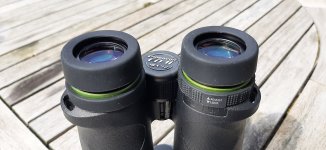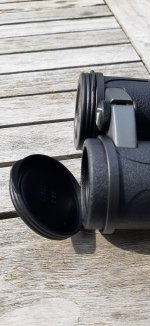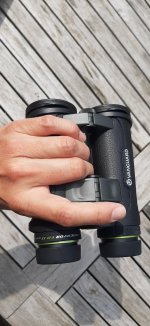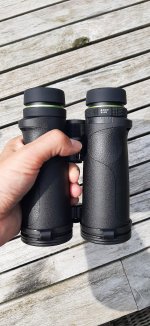Sooo ... my quest has come to a close. Surprisingly (even for myself), I have not settled on a compact 8x32 but on a 10x42, the Vanguard Endeavour ED II 10x42, to be exact. Here are my thoughts on this sweetie.
Height and weight
Of course, I knew beforehand that these binoculars were bigger and heavier than the small 32 mm glass from Carson. With a re-measured 780 grams (including lens and eyepiece covers), the Vanguard glass is so heavy that I initially had doubts about how many occasions I would really take it with me or whether I wouldn't rather keep going back to my lighter Carson glass.
Build quality and handling
There isn't much to complain about in terms of workmanship. Thanks to the open bridge, the binoculars sit comfortably in the hand and look and feel very solid, partly due to their weight.
The rubber armoring is comparatively hard and smooth, which I like a lot. There are subtle indentations for the thumbs on the underside, which further supports the ergonomic design. In short: it feels really good in the hands.
The focus wheel can be turned with rather little resistance, but absolutely smoothly and without play or the like. It is very quick, i.e. you only need to turn a little to switch from very close to far away. I already know that from my Carson glass and that's basically how I like it. However, especially at a distance, you need a LOT of sensitivity with the Vanguard glass. So if you are a bit concerned about that, you should perhaps use another model with a less aggressive focus mechanism.
As with practically all binoculars in this and lower price range, the ring for adjusting the dioptre setting is located on the right eyepiece and can be locked. A nice little extra that you won't find with other models in this price range.
The twist-up eyecups turn rather stiffly at first and not as crisp as I usually prefer. The snap-in points are also rather shorter "plateaus" in the thread, at the end of which the eyecups move a little bit back towards the body, if that makes sense. The eyecups are not "held on to" as much as I know from other models. However, this construction offers the advantage that even after a long time of use there is not so much the risk of the eyecups being inadvertently screwed in when they are pressed against the face or the glasses. In the meantime, after some months of use, the eyecups can be twisted in and out with very little resistance, which might cause problems for some. But as I have to keep my glasses on I have them twisted all the way down anyway, so no problem for me here.
The bridge can only be adjusted with a certain amount of force, which I find rather positive, because the interpupillary distance does not easily get out of alignment inadvertently.
As is common in this price range, the Vanguard Endeavor ED II is waterproof and filled with nitrogen to prevent moisture inside the binoculars (and consequential damage such as mold).
Image quality
The edge sharpness of these bins is particularly impressive. With my Carson glass, it always annoyed me (and still annoys me) that the image is not sharp over the entire field of view, but that the sharpness drops off considerably after about two thirds on the way to the edge of the field of view. For the "static" observation of birds, this is not a problem, but panning, for example to scan a group of shorebirds, is anything but a pleasure. Here the binoculars from Vanguard definitely score with sharpness over the entire field of view. I have now noticed that I can look through these binoculars for much longer and look around within the field of vision in a much more relaxed and fatigue-free manner.
Most of the other parameters of the image quality are also very good: the short close focus also allows the observation of insects at the wayside and the field of view is pleasantly large for this configuration. The long eye relief makes the binoculars also suitable for people who wear glasses, who, like me, do not take off their glasses when looking through the binoculars. I even had to turn the eyecups out a notch so as not to get this annoying "flying" shadow on the edge of the picture. With a little practice, however, I can now keep the eyecups fully twisted down.
Oh yes, and there is hardly any glare in the image - I'm so relieved!
What you can complain about is a slightly yellowish color cast. In most situations it is not really noticeable, but e.g. the color of the blue sky does not seem to be that pure.
Chromatic aberrations are also not controlled quite as well as I had expected, given the use of ED glass and the manufacturer's advertising claims ("practically eliminates chromatic aberration"). But again: in the vast majority of everyday situations, chromatic aberrations are not really annoying or even noticeable.
Equipment and accessories
The equipment can be described as average for this price range.
A nylon storage and transport bag and a neck strap are supplied with the binoculars. The positive thing about the bag is the zipper, which promises to be quieter and more durable than a Velcro fastener that is often found here. The (unfortunately somewhat short) shoulder strap of the bag can be connected to the shoulder strap for the binoculars via snap connectors and thus extended. In my opinion, however, it would have been better to equip both the bag and the binoculars with a long strap instead of always having to change one strap back and forth. On the positive side, the binoculars fit into the pocket even with the neck strap attached. It gets a bit tight and you first have to get the hang of how and where to fold the neck strap, but it works, and that is quite something.
There really is nothing negative to say about the neck strap in this price range. It is well padded and wide enough and comfortable to wear.
The equipment also includes a thread on the front of the front bridge to which a tripod adapter can be screwed. It is positive that the thread of the protective cap is made of metal.
A lens cleaning cloth is also included, but I would consider this to be something only to be used in cases of emergency. Better use a lens cleaning kit for regular care.
Conclusion
The bottom line is that there are two small bullets to bite with these binoculars: the focus mechanism, which is a bit too aggressive even for my taste, and the slightly yellowish color cast. And to make a pair of binoculars for this price without any further things to complain about is a reamarkable achievement. I haven't found anything better for less than 300 euros and therefore kept the Vanguard Endeavor ED II 10x42. With the high edge sharpness, completely different types of observations are suddenly possible. Searching through groups of birds on the water or on the shore through the binoculars was simply not comfortable enough for me with my previous binoculars. With these binoculars this is no longer a problem at all. It is probably no coincidence that since I call these binoculars my own, I have become much more interested in ducks, grebes, etc. than ever before. But in all other situations, too, the view through these binoculars is so much more relaxed and overall better that my previous Carson binoculars, that -- contrary to what I had originally intended -- I don't use these Vanguards as an addition to but rather as a replacement for my Carsons. I gladly accept the significantly higher weight even for occasional observations and may daily walks with the dog.










